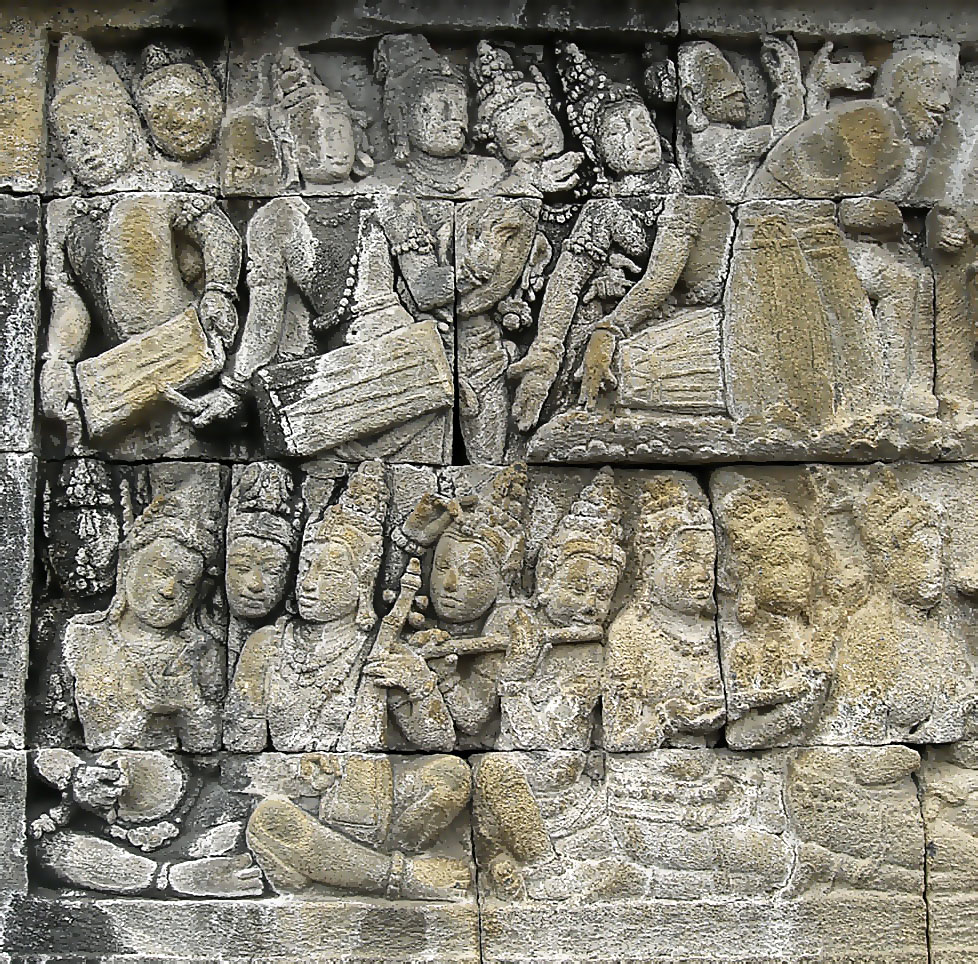|
Pygmy Music
Pygmy music refers to the sub-Saharan African music traditions of the Central African foragers (or "Pygmies"), predominantly in Democratic Republic of the Congo, the Congo, the Central African Republic and Cameroon. Pygmy groups include the Bayaka, the Mbuti, and the Twa peoples, Batwa. Music is an important part of Pygmy life, and casual performances take place during many of the day's events. Music comes in many forms, including the spiritual likanos stories, vocable singing and music played from a variety of instruments including the bow harp (''ieta''), ''ngombi'' (harp zither) and ''limbindi'' (a string bow). Researchers who have studied Pygmy music include Simha Arom, Louis Sarno, Colin Turnbull and Jean-Pierre Hallet. Polyphonic song The Mbenga (Aka people, Aka/Benzele) and Baka peoples in the west and the Mbuti (Efé) in the east are particularly known for their dense counterpoint, contrapuntal communal improvisation. Simha Arom says that the level of polyphonic c ... [...More Info...] [...Related Items...] OR: [Wikipedia] [Google] [Baidu] |
Africa Speaks! (1930) - Pygmy Drummers
''Africa Speaks!'' is a 1930 American documentary film directed by Walter Futter and narrated by Lowell Thomas. It is an exploitation film. Premise Paul L. Hoefler heads a 1928 expedition to Africa capturing wildlife and tribes on film. Production Although the film was shot over the fourteen months of the expedition in the Serengeti and in Uganda Uganda, officially the Republic of Uganda, is a landlocked country in East Africa. It is bordered to the east by Kenya, to the north by South Sudan, to the west by the Democratic Republic of the Congo, to the south-west by Rwanda, and to the ..., a scene involving an attack by a lion on a native was apparently staged at the Selig Zoo in Los Angeles and involved a toothless lion. Hoefler wrote a book entitled ''Africa Speaks'' about the expedition that was published in 1931. References in popular culture The title of the film was parodied in the 1940 cartoon '' Africa Squeaks'' and the 1949 Abbott and Costello film '' A ... [...More Info...] [...Related Items...] OR: [Wikipedia] [Google] [Baidu] |
Colin Turnbull
Colin Macmillan Turnbull (23 November 1924 – 28 July 1994) was a British-American anthropologist who came to public attention with the popular books '' The Forest People'' (on the Mbuti Pygmies of Zaire) and '' The Mountain People'' (on the Ik people of Uganda), and one of the first anthropologists to work in the field of ethnomusicology. Early life Turnbull was born in London and educated at Westminster School and Magdalen College, Oxford, where he studied politics and philosophy. During World War II he was in the Royal Naval Volunteer Reserve after which he was awarded a two-year grant in the Department of Indian Religion and Philosophy, Banaras Hindu University, India, from which he graduated with a master's degree in Indian Religion and Philosophy. Career In 1951, after his graduation from Banaras, Turnbull traveled to the Belgian Congo (present-day Democratic Republic of the Congo) with Newton Beal, a schoolteacher from Ohio he met in India. Turnbull and Beal first stud ... [...More Info...] [...Related Items...] OR: [Wikipedia] [Google] [Baidu] |
Gamelan
Gamelan (; ; , ; ) is the traditional musical ensemble, ensemble music of the Javanese people, Javanese, Sundanese people, Sundanese, and Balinese people, Balinese peoples of Indonesia, made up predominantly of percussion instrument, percussive instruments. The most common instruments used are metallophones (played with mallets) and a set of hand-drums called ''kendang'', which keep the beat (music), beat. The ''kemanak'', a banana-shaped idiophone, and the ''gangsa'', another metallophone, are also commonly used gamelan Musical instrument, instruments on Bali. Other notable instruments include xylophones, bamboo flutes (similar to the Indian ''bansuri''), a bowed string instrument called a ''rebab'' (somewhat similar to the ''gadulka'' of Bulgaria), and a zither-like instrument called a ''siter'', used in Javanese gamelan. Additionally, vocalists may be featured, being referred to as ''sindhen'' for females or ''gerong'' for males.Sumarsam (1998)''Introduction to Javanese ... [...More Info...] [...Related Items...] OR: [Wikipedia] [Google] [Baidu] |
Bali
Bali (English:; Balinese language, Balinese: ) is a Provinces of Indonesia, province of Indonesia and the westernmost of the Lesser Sunda Islands. East of Java and west of Lombok, the province includes the island of Bali and a few smaller offshore islands, notably Nusa Penida, Nusa Lembongan, and Nusa Ceningan to the southeast. The provincial capital, Denpasar, is the List of Indonesian cities by population, most populous city in the Lesser Sunda Islands and the second-largest, after Makassar, in Eastern Indonesia. Denpasar metropolitan area is the extended metropolitan area around Denpasar. The upland town of Ubud in Greater Denpasar is considered Bali's cultural centre. The province is Indonesia's main tourist destination, with a significant rise in Tourism in Bali, tourism since the 1980s, and becoming an Indonesian area of overtourism. Tourism-related business makes up 80% of the Bali economy. Bali is the only Hinduism in Indonesia, Hindu-majority province in Indonesia, ... [...More Info...] [...Related Items...] OR: [Wikipedia] [Google] [Baidu] |
Passacaglia
The passacaglia (; ) is a musical form that originated in early seventeenth-century Spain and is still used today by composers. It is usually of a serious character and is typically based on a bass- ostinato and written in triple metre. Origin The term passacaglia (; ; Italian: ''passacaglia'', ''passacaglio'', ''passagallo'', ''passacagli'', ''passacaglie'') derives from the Spanish ''pasar'' (cross, pass) and ''calle'' (street). It originated in early 17th-century Spain as a strummed interlude between instrumentally accompanied dances or songs. Despite the form's Spanish roots (confirmed by references in Spanish literature of the period), the first written examples of passacaglias are found in an Italian source dated 1606. These pieces, as well as others from Italian sources from the beginning of the century, are simple, brief sequences of chords outlining a cadential formula. The passacaglia was redefined in the late 1620s by Italian composer Girolamo Frescobaldi, who trans ... [...More Info...] [...Related Items...] OR: [Wikipedia] [Google] [Baidu] |
Variation (music)
In music, variation is a musical form, formal technique where material is musical repetition, repeated in an altered form. The changes may involve melody, rhythm, harmony, counterpoint, timbre, orchestration or any combination of these. Variation is often contrasted with musical Development (music), development, which is a slightly different means to the same end. Variation depends upon ''one'' type of presentation at a time, while development is carried out upon portions of material treated in ''many'' different presentations and combinations at a time. Variation techniques Wolfgang Amadeus Mozart, Mozart's Twelve Variations on "Ah vous dirai-je, Maman" (1785), a French folk song known in the English-speaking world as "Twinkle, Twinkle, Little Star", exemplifies a number of common variation techniques. Here are the first eight bars of the theme: Melodic variation Mozart's first variation decorates and elaborates the plain melodic line: Rhythmic variation The fifth variat ... [...More Info...] [...Related Items...] OR: [Wikipedia] [Google] [Baidu] |
Ostinato
In music, an ostinato (; derived from the Italian word for ''stubborn'', compare English ''obstinate'') is a motif or phrase that persistently repeats in the same musical voice, frequently in the same pitch. Well-known ostinato-based pieces include classical compositions such as Ravel's ''Boléro'' and the '' Carol of the Bells'', and popular songs such as John Lennon’s “Mind Games” (1973), Donna Summer and Giorgio Moroder's " I Feel Love" (1977), Henry Mancini's theme from ''Peter Gunn'' (1959), The Who's " Baba O'Riley" (1971), The Verve's " Bitter Sweet Symphony" (1997), and Flo Rida's " Low" (2007). Both ''ostinatos'' and ''ostinati'' are accepted English plural forms, the latter reflecting the word's Italian etymology. The repeating idea may be a rhythmic pattern, part of a tune, or a complete melody in itself. Kamien, Roger (1258). ''Music: An Appreciation'', p. 611. . Strictly speaking, ostinati should have exact repetition, but in common usage, the term cover ... [...More Info...] [...Related Items...] OR: [Wikipedia] [Google] [Baidu] |
Representative List Of The Intangible Cultural Heritage Of Humanity
UNESCO established its Lists of Intangible Cultural Heritage with the aim of ensuring better protection of important intangible cultural heritages worldwide and the awareness of their significance.Compare: This list is published by the Intergovernmental Committee for the Safeguarding of Intangible Cultural Heritage, the members of which are elected by State Parties meeting in a General Assembly. Through a compendium of the different oral and intangible treasures of humankind worldwide, the programme aims to draw attention to the importance of safeguarding intangible heritage, which UNESCO has identified as an essential component and as a repository of cultural diversity and of creative expression. The list was established in 2008 when the 2003 Convention for the Safeguarding of the Intangible Cultural Heritage took effect. , the programme compiles three lists. The longer Representative List of the Intangible Cultural Heritage of Humanity comprises cultural "practices and expressi ... [...More Info...] [...Related Items...] OR: [Wikipedia] [Google] [Baidu] |
Aka (Pygmy Tribe)
The Aka or Biaka (also ''Bayaka, ''Babenzele) are a nomadic Mbenga pygmy people. They live in south-western Central African Republic and in northern Republic of the Congo. They are related to the Baka people of Cameroon, Gabon, northern Congo, and southwestern Central African Republic. Unlike the Mbuti pygmies of the eastern Congo (who speak only the language of the tribes with whom they are affiliated), the Aka speak their own language along with whichever of the approximately 15 Bantu peoples they are affiliated. In 2003, the oral traditions of the Aka were proclaimed one of the Masterpieces of the Oral and Intangible Heritage of Humanity by UNESCO. They were featured in the July 1995 National Geographic article "Ndoki: the Last Place on Earth", and a 3-part TV series. Society A traditional hunter-gatherer society, the Aka have a varied diet that includes 63 plants, 28 species of game and 20 species of insect, in addition to nuts, fruit, honey, mushrooms and roots.Ba ... [...More Info...] [...Related Items...] OR: [Wikipedia] [Google] [Baidu] |
Polyphonic
Polyphony ( ) is a type of musical texture consisting of two or more simultaneous lines of independent melody, as opposed to a musical texture with just one voice ( monophony) or a texture with one dominant melodic voice accompanied by chords ( homophony). Within the context of the Western musical tradition, the term ''polyphony'' is usually used to refer to music of the late Middle Ages and Renaissance. Baroque forms such as fugue, which might be called polyphonic, are usually described instead as contrapuntal. Also, as opposed to the ''species'' terminology of counterpoint, polyphony was generally either "pitch-against-pitch" / "point-against-point" or "sustained-pitch" in one part with melismas of varying lengths in another. In all cases the conception was probably what Margaret Bent (1999) calls "dyadic counterpoint", with each part being written generally against one other part, with all parts modified if needed in the end. This point-against-point conception is oppose ... [...More Info...] [...Related Items...] OR: [Wikipedia] [Google] [Baidu] |
Improvisation
Improvisation, often shortened to improv, is the activity of making or doing something not planned beforehand, using whatever can be found. The origin of the word itself is in the Latin "improvisus", which literally means un-foreseen. Improvisation in the performing arts is a very spontaneous performance without specific or scripted preparation. The skills of improvisation can apply to many different faculties across all artistic, scientific, physical, cognitive, academic, and non-academic disciplines; see Applied improvisation. Skills and techniques The skills of improvisation can apply to many different abilities or forms of communication and expression across all artistic, scientific, physical, cognitive, academic, and non-academic disciplines. For example, improvisation can make a significant contribution in music, dance, cooking, presenting a speech, sales, personal or romantic relationships, sports, flower arranging, martial arts, psychotherapy, and much more. Technique ... [...More Info...] [...Related Items...] OR: [Wikipedia] [Google] [Baidu] |
Counterpoint
In music theory, counterpoint is the relationship of two or more simultaneous musical lines (also called voices) that are harmonically dependent on each other, yet independent in rhythm and melodic contour. The term originates from the Latin ''punctus contra punctum'' meaning "point against point", i.e. "note against note". John Rahn describes counterpoint as follows: Counterpoint has been most commonly identified in the European classical tradition, strongly developing during the Renaissance and in much of the common practice period, especially in the Baroque period. In Western pedagogy, counterpoint is taught through a system of species (see below). There are several different forms of counterpoint, including imitative counterpoint and free counterpoint. Imitative counterpoint involves the repetition of a main melodic idea across different vocal parts, with or without variation. Compositions written in free counterpoint often incorporate non-traditional harmonies and c ... [...More Info...] [...Related Items...] OR: [Wikipedia] [Google] [Baidu] |







